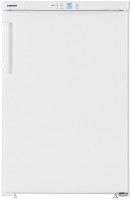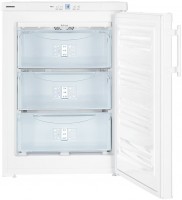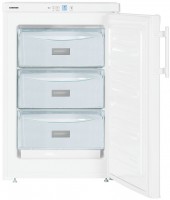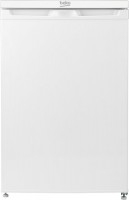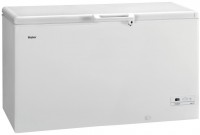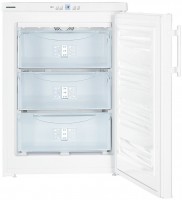Freezers Liebherr
All Freezers Advanced filters → |
You might be interested in
Articles, reviews, useful tips
All materials
Inverter drive in household appliances: what is it, the pros and cons of inverter control
The inverter provides more efficient, economical and quiet operation of household appliances

Climate classes of refrigerators and freezers
What is behind the symbols N, SN, ST and T in the designation of the climatic classes of refrigeration equipment? ..

The best countertop freezers
The 85 cm high freezer is a great addition to a refrigerator in a small kitchen

TOP-5 economical capacious freezers
Energy efficient freezers for medium to large families

How to choose a freezer
Recommendations for choosing a freezer for long-term food storage

How to properly store food in the freezer?
What can and cannot be stored in the freezer, how to pack and zone, what temperatures to set
Freezers: specifications, types
Show all
Product type
— Freezer. A device for storing frozen food, made in the form of a cabinet with a vertically located door. Freezers are convenient because they can occupy a relatively small area with significant capacity.
— Chest freezer. A device for storing frozen food, made in the form of a chest, that is, a horizontally located box, in which the top cover acts as a door. The chest has a small height and, as a result, occupies a larger area than freezers. On the other hand, they are more convenient for storing bulky products and allow you to use the entire working volume without dividing it into boxes.
— Display chest showcase. Freezer designed for commercial use. It has a transparent top cover through which the buyer can view the product without opening the device; the same cover usually serves as a door. Display chest showcases can be seen in modern stores. They store ice cream and semi-finished products.
— Ice maker. Unlike other types of freezers, the ice maker is designed not to store food but to produce edible ice in large quantities. Such units are widely used in cafes, restaurants and bars, where chilled drinks often have to be prepared.
— Shock freezer. A shock freezer is a high-capacity freezer. Shock freezing involves the processing of products with a temperature of 30 to 50 °C below zero. At this tempe...rature, the tissue structure freezes at the micro level. It is very important because, in the products subjected to shock freezing, the tissues are not damaged so that the products will not turn into a liquid during defrosting, and it also makes it possible to preserve the original microelement and vitamin composition in the products. Thanks to shock freezing, you can harvest any vegetables, berries, fruits, etc. After defrosting, the products will acquire the same appearance and taste properties as at the start of shock freezing. After quick and deep freezing, the low-temperature zone switches to the mode of operation of an ordinary freezer.
— Chest freezer. A device for storing frozen food, made in the form of a chest, that is, a horizontally located box, in which the top cover acts as a door. The chest has a small height and, as a result, occupies a larger area than freezers. On the other hand, they are more convenient for storing bulky products and allow you to use the entire working volume without dividing it into boxes.
— Display chest showcase. Freezer designed for commercial use. It has a transparent top cover through which the buyer can view the product without opening the device; the same cover usually serves as a door. Display chest showcases can be seen in modern stores. They store ice cream and semi-finished products.
— Ice maker. Unlike other types of freezers, the ice maker is designed not to store food but to produce edible ice in large quantities. Such units are widely used in cafes, restaurants and bars, where chilled drinks often have to be prepared.
— Shock freezer. A shock freezer is a high-capacity freezer. Shock freezing involves the processing of products with a temperature of 30 to 50 °C below zero. At this tempe...rature, the tissue structure freezes at the micro level. It is very important because, in the products subjected to shock freezing, the tissues are not damaged so that the products will not turn into a liquid during defrosting, and it also makes it possible to preserve the original microelement and vitamin composition in the products. Thanks to shock freezing, you can harvest any vegetables, berries, fruits, etc. After defrosting, the products will acquire the same appearance and taste properties as at the start of shock freezing. After quick and deep freezing, the low-temperature zone switches to the mode of operation of an ordinary freezer.
Capacity
It is the total working capacity of the freezer. A larger capacity allows you to accommodate more products but affects the dimensions and cost of the unit. Therefore, when choosing according to this parameter, you should not chase after the maximum capacity but the capacity you really need. For example, the average required capacity is 50 litres per person. And when choosing a display chest freezer (see "Product type"), you need to take into account the number of products offered for sale.
It is also worth considering that the freezer is often divided into several compartments (see below) - which means that a large capacity does not guarantee that large pieces of food can fit in the device.
It is also worth considering that the freezer is often divided into several compartments (see below) - which means that a large capacity does not guarantee that large pieces of food can fit in the device.
Inverter compressor
Unlike classic compressors, inverter compressors constantly operate, while the pump power changes depending on current needs. Freezers with compressors of this type lack the main drawback: regular on/off, which negatively affects the durability, energy consumption and noise of the device. On the other hand, such units are expensive.
No Frost
No Frost system inside the freezer. A special fan provides air circulation, while moisture condenses in the frost, not in the working chamber, but in a special compartment. Periodically, the fan turns off, the frost melts, and the meltwater flows into a special tray, from which it evaporates. Such a system eliminates the need to defrost the freezer to remove frost periodically. On the other hand, it imposes special requirements on the packaging of products, since in such freezers the products dehydrate fast.
Number of compartments
it is the number of compartments provided in the design of the freezer. In some models, it is possible to set different temperatures for different compartments. It is worth noting that a large number of boxes does not always mean maximum convenience, since, with an increase in their number, the volume of each individual box inevitably decreases.
Big drawer
The presence of an oversized drawer in the freezer. Such large containers allow you to store a whole turkey and other bulky products. It is worth noting that each manufacturer has a different concept of a large drawer. And in some models, it is quite possible that the large drawer will be commensurate with the classic drawer of another model.
Slim shelf
The slim shelf is a low (up to 5 cm) tray, and is best suited for storing seasonings, rolled puff pastry, ice, butter and other small-sized products. In such a container, you can’t place products on top of the other, so finding the needed frozen item will be much easier.
Door shelves
The shelves inside the freezer door will serve as a haven for small products in the manner of a pack of butter or ice cream. They also facilitate quick access to the above-mentioned content. Note that the number of shelves can be different, and depending on the manufacturer of the freezer equipment and the internal arrangement of the unit, they can be different in width. In any case, door shelves in the amount of several pieces are much more convenient for the distribution of small products.
Telescopic rails
Retractable guides allow the drawer to roll smoothly on a special roller. The main advantage of telescopic rails is that you do not need to make much effort. On the other hand, such devices are more expensive and are used in premium segment devices.
Max. temperature
The highest temperature maintained by the freezer during normal operation. This parameter is not as important as the minimum freezing temperature, however, it allows to evaluate the optimal conditions for storing certain categories of products that do not need deep freezing. And in some cases, it shows that the freezer can work as a refrigerator.
Minimum temperature
The lowest temperature that the freezer can maintain in normal operation. First of all, the duration of food storage in the freezer depends on this parameter: it is believed that a temperature of -12 ° C is enough to preserve food for a month, -18 ° C – 3 months, -24 ° C – up to a year. At the same time, it must be taken into account that not only temperature affects the shelf life but also the type of product and its quality before freezing.
Power failure autonomy
The amount of time the freezer keeps food cold enough when the refrigeration system is turned off, for example, due to a breakdown or power outage. Technically, the power failure autonomy for each model is calculated differently; For example, for a freezer with an operating temperature of -18 ° C, this is the period during which the products in the chamber heat up from -18 ° C to -9 ° C. To sum up, the time is indicated during which the frozen products are guaranteed not to heat up to a temperature at which they could lose their properties.
Freeze capacity
One of the main indicators of freezer performance is the approximate amount of fresh food that the freezer can completely freeze from room temperature to the minimum operating temperature in 24 hours. For domestic use, a power of 10-15 kg/day is considered quite sufficient. More performant models may be required if you have to freeze a lot of food at a time or for industrial purposes.
Fast freeze
It is the forced freezing mode, in which the temperature inside the freezer is briefly reduced to -24 °C. This mode is intended for the case when you need to freeze numerous products at the same time — without a sharp decrease in temperature, the heat from numerous non-frozen products could lead to its critical increase.
Usually, the fast freeze mode must be turned on in advance — 5 to 6 hours before loading the products. Thus the freezer has time to decrease the temperature in the chamber. In this case, it is necessary to take into account the increased load on the compressor — it is impossible to turn on fast freeze for a long time. In some models, automatic shutdown of the fast freeze mode is provided. In some, it must be done manually.
Usually, the fast freeze mode must be turned on in advance — 5 to 6 hours before loading the products. Thus the freezer has time to decrease the temperature in the chamber. In this case, it is necessary to take into account the increased load on the compressor — it is impossible to turn on fast freeze for a long time. In some models, automatic shutdown of the fast freeze mode is provided. In some, it must be done manually.
Ice maker
It is a separate device for producing edible ice in the freezer. One of the advantages of such freezers is that the ice is produced and stored separately from other products and thus does not absorb foreign odours.
Lighting
Freezer interior lighting system. This function is very helpful given that the working chamber of the unit, even with the door open, is often shaded, and it is not so easy to see its contents. The lighting usually works automatically — similar to how it is implemented in refrigerators: the light turns on when the door is opened and turns off when it is closed.
Mechanical lock
If a child lock provides for electronic locking of controls, then mechanical lock is a lock for the door, which can be opened with a key. This solution is in high demand in chest freezers intended for non-domestic use.
Reversible door
It is a feature that allows the user to choose which way the freezer door will open. It allows you to optimize the space in the room where the device is installed, which is especially important in cramped conditions.
Door closer
The door auto-closer is responsible for “pulling” the door when closing, and in some models also when opening. The idea is that the user does not need to close/open the door completely: pull it to the right place, and then the door will be "picked up" by the auto-closer and smoothly brought to a fully open or closed state. Such a system performs two functions. Firstly, it reduces the risk of leaving the freezer not closed. Secondly, such a device provides a very smooth opening and closing without shock. Thus it has a positive impact on the life span of the entire device.
Door alarm
It is a system that monitors the closing of the freezer door. If the door is not closed for a long time or is not closed tightly enough, an audible or light (depending on the model) signal is given. It helps to avoid a critical increase in temperature in the working chamber and preserves the quality of the products.
Hidden door handle
A handle made in the form of a notch at the end of the door. Thanks to the hidden handle, the freezer at least gets a neat, discreet appearance — with a minimum of unnecessary details on the doors. In addition, a traditional handle can be touched by careless movement, but with a hidden one, it is impossible. It is especially relevant in cramped conditions.
Controls
The type of control provided in the freezer. This parameter is specified by the type of controls and their location.
- Rotary knobs. In general, this is the simplest and most inexpensive option used in units of the appropriate level. However, even this is quite enough - especially if the freezer works in more or less constant temperature conditions (for example, in a home or office kitchen). In many cases, the matter is limited to selecting the appropriate knob position once and then not changing the settings. In addition, the major advantages of this type of control are reliability and ease of repair.
- Push-buttons. Push-buttons are considered more advanced than rotary knobs. The specific functionality of freezers with such a control may be different. But among them, models with additional functions and the ability to fine-tune the temperature are noticeably more common. As for the location, there are internal and external push-buttons. The internal location allows you to hide the control panel behind the refrigerator door, providing a neat appearance with a minimum of protruding parts.
The external location is convenient because you do not need to open the door to access the settings. On the other hand, the real need for such an arrangement is not so often, and the control panel must also fit into the overall design of the unit (which is not always possible to do in the best way).
- Touch controls. Touch controls are considered th...e next step in the development of control panels, after buttons. So, it looks stylish and technologically advanced, they do not need to be pressed hard (just touched), and there are no protruding parts, corners or slots on the surface of the panel, which simplifies cleaning from dirt. The presence of a touch panel is typical mainly for models of the middle and top levels. It costs a little more than a push-button one, but this is imperceptible against the total price of the units. But the internal location, in this case, is much less common than the external one. It is because there is no need to hide the touch panel behind the door. It can easily fit into the design of the device. In addition, external placement allows you not to open the door again to access the settings.
- Rotary knobs. In general, this is the simplest and most inexpensive option used in units of the appropriate level. However, even this is quite enough - especially if the freezer works in more or less constant temperature conditions (for example, in a home or office kitchen). In many cases, the matter is limited to selecting the appropriate knob position once and then not changing the settings. In addition, the major advantages of this type of control are reliability and ease of repair.
- Push-buttons. Push-buttons are considered more advanced than rotary knobs. The specific functionality of freezers with such a control may be different. But among them, models with additional functions and the ability to fine-tune the temperature are noticeably more common. As for the location, there are internal and external push-buttons. The internal location allows you to hide the control panel behind the refrigerator door, providing a neat appearance with a minimum of protruding parts.
The external location is convenient because you do not need to open the door to access the settings. On the other hand, the real need for such an arrangement is not so often, and the control panel must also fit into the overall design of the unit (which is not always possible to do in the best way).
- Touch controls. Touch controls are considered th...e next step in the development of control panels, after buttons. So, it looks stylish and technologically advanced, they do not need to be pressed hard (just touched), and there are no protruding parts, corners or slots on the surface of the panel, which simplifies cleaning from dirt. The presence of a touch panel is typical mainly for models of the middle and top levels. It costs a little more than a push-button one, but this is imperceptible against the total price of the units. But the internal location, in this case, is much less common than the external one. It is because there is no need to hide the touch panel behind the door. It can easily fit into the design of the device. In addition, external placement allows you not to open the door again to access the settings.
Control via smartphone
The freezer can be controlled remotely using a phone or tablet, thanks to its Wi-Fi connection and a corresponding app that allows access to various settings. This feature may increase the cost but also provides added convenience.
Display
The external display makes the operation of the freezer more intuitive and allows you to control the conditions inside without opening it. The display can show data on the temperature inside the chamber or individual drawers, running programmes and the state of their running(fast freeze, for example), etc.
Child lock
The child lock allows you to block freezer controls and/or access to its internal volumes. This function will be useful in families where there are small children. Thus, the child will not be able to get to the freezer controls and change its operation mode.
Cold accumulators
The presence of removable refrigerants (cold accumulators) in the freezer design. This solution allows you to extend the temperature retention time in case of a power outage and also allows you to take it with you for use outside the freezer if necessary.
Energy class
The energy class shows how economical the freezer is in terms of electricity consumption. Initially, the classes were designated in Latin letters from A (most economical) to G (high power consumption). Recently, improved classes A+, A++ and A+++ appeared (the more pluses - the more economical the device).
It should be borne in mind that this indicator represents not the actual energy consumption but the efficiency of the unit compared to similar models. Therefore, a small class A freezer may have a lower power consumption than a large class A++ model. And other things being equal, a more economical device, as a rule, costs more, but this difference can quickly pay off during the operation.
It should be borne in mind that this indicator represents not the actual energy consumption but the efficiency of the unit compared to similar models. Therefore, a small class A freezer may have a lower power consumption than a large class A++ model. And other things being equal, a more economical device, as a rule, costs more, but this difference can quickly pay off during the operation.
Energy class (new)
This parameter shows the efficiency of electricity consumption by the freezer. Classes are designated in Latin letters from A to G, in ascending order of energy consumption. It was originally conceived until more energy-efficient models pulled up to class A, which eventually received the marking A+, A++, and A+++. Further development of technology has made it possible to go even further and, in order not to produce pluses in energy efficiency labelling, in March 2021, manufacturers returned to the previous indices from G to A, where A is the most energy-efficient freezer. Accordingly, the 2021 models will have modern markings, while older models will be marked the old way.
Energy consumption per year
It is the average amount of energy consumed by the freezer in a year of operation. Of course, these figures are not absolutely accurate. The actual power consumption may vary depending on the specific operating conditions. However, this parameter makes it possible to evaluate the consumption of the device and compare different models with each other. At the same time, it often turns out to be more convenient and visual than the energy consumption class (see above) because, in this paragraph, we are talking about a specific figure (from which you can also calculate the cost of electricity consumed).
Climate class
The climate class to which the freezer corresponds.
As the name implies, this parameter describes the environmental conditions for which the unit is designed. The warmer it is around, the more powerful the freezer should be and the better thermal insulation it should have. Specific classes are indicated by letters. Here are the most popular options:
— SN (subnormal). Models for a cool temperate climate have an operating range from +10 °C to + 32 °C. Such a unit can be useful in a poorly heated room where the temperature can drop below +16 °C — for example, on the veranda of a private house, in a garage, etc.
— N (normal). Freezer for a temperate climate, with an operating temperature range of +16...+32 °C. Such a unit is suitable for most residential apartments and houses in mid-latitudes.
— ST (subtropical). Models for subtropical and humid tropical climates. Normally they work at the range of external temperatures +18...+38 °C.
— T (tropical). Refrigerators for dry tropical climates. Designed for temperature range +18 °C to +43 °C.
Also, note that there are many models on the market with an extended temperature range covering several classes. For example, a unit labelled N-ST will have a temperature range of +16...+38 °C. These freezers are indispensable in climates, conditions which are not covered by one standard class — for example, in cold winters and hot summers.
As the name implies, this parameter describes the environmental conditions for which the unit is designed. The warmer it is around, the more powerful the freezer should be and the better thermal insulation it should have. Specific classes are indicated by letters. Here are the most popular options:
— SN (subnormal). Models for a cool temperate climate have an operating range from +10 °C to + 32 °C. Such a unit can be useful in a poorly heated room where the temperature can drop below +16 °C — for example, on the veranda of a private house, in a garage, etc.
— N (normal). Freezer for a temperate climate, with an operating temperature range of +16...+32 °C. Such a unit is suitable for most residential apartments and houses in mid-latitudes.
— ST (subtropical). Models for subtropical and humid tropical climates. Normally they work at the range of external temperatures +18...+38 °C.
— T (tropical). Refrigerators for dry tropical climates. Designed for temperature range +18 °C to +43 °C.
Also, note that there are many models on the market with an extended temperature range covering several classes. For example, a unit labelled N-ST will have a temperature range of +16...+38 °C. These freezers are indispensable in climates, conditions which are not covered by one standard class — for example, in cold winters and hot summers.
Operation at sub-zero temperatures
The ability of freezer to work at sub-zero temperatures allows you to take it out to an unheated room. And chest freezers can be used outdoors.
Noise level
The average noise level generated by the freezer during operation. The quietest models give out about 25 - 30 dB — this is the average noise background in a residential area at night (comparable to the ticking of a wall clock); the loudest — is about 60 dB (loud conversation). More detailed comparison tables can be found in special sources.
In any case, the lower the noise level, the more comfortable the use of the unit. However, it does not always make sense to look for the quietest freezer: in some situations (for example, in a noisy workshop), the freezer's sound may be lost against the surrounding noise background. In addition, reduced noise often affects the price.
In any case, the lower the noise level, the more comfortable the use of the unit. However, it does not always make sense to look for the quietest freezer: in some situations (for example, in a noisy workshop), the freezer's sound may be lost against the surrounding noise background. In addition, reduced noise often affects the price.
Noise class
This parameter allows one to decipher the noise level in decibels. It is marked, like other classes, in Latin letters, where A is the quietest class of wine cabinets.
Door panel hinge
— Sliding hinget. A sliding hinge involves the connection of a decorative panel with a freezer door using movable guides. So, with the sliding hinge, the front decorative facade is equipped with its hinges, and the freezer door is practically not loaded by the panel. On the other hand, with this type of hinge, there is a small gap between the decorative panel and the freezer door, in which dust can accumulate. Additionally, the sliding hinge does not allow the freezer door to be opened more than 90-95˚.
— Fixed hinge. With a fixed hinge, the panel is hung on the freezer door. It is the easiest and fastest option for installing the decorative panel. The fixed hinge assumes that the decorative panel loads the door hinges of the freezer. When choosing the fixed hinge for the panel, it should be taken into account that if the door of the freezer is not sufficiently reliable, the door of the built-in unit may be overloaded. Most often, the fixed hinge of the panel is used when installing a relatively small freezer. The compact panel is unlikely to overload the freezer door.
Country of origin
It is the country in which, according to the manufacturer, this or that model is manufactured. Even though most of the capacities are concentrated in China, European factories for the production of household appliances have not disappeared. And some models can be produced there. In general, such a division into a Chinese or European factory should not particularly affect the quality of products, but the stereotype of a reliable European assembly is present. However, it is possible that the model may have a country of manufacture, for example, Poland, and in the store under the same article, you will meet China.

